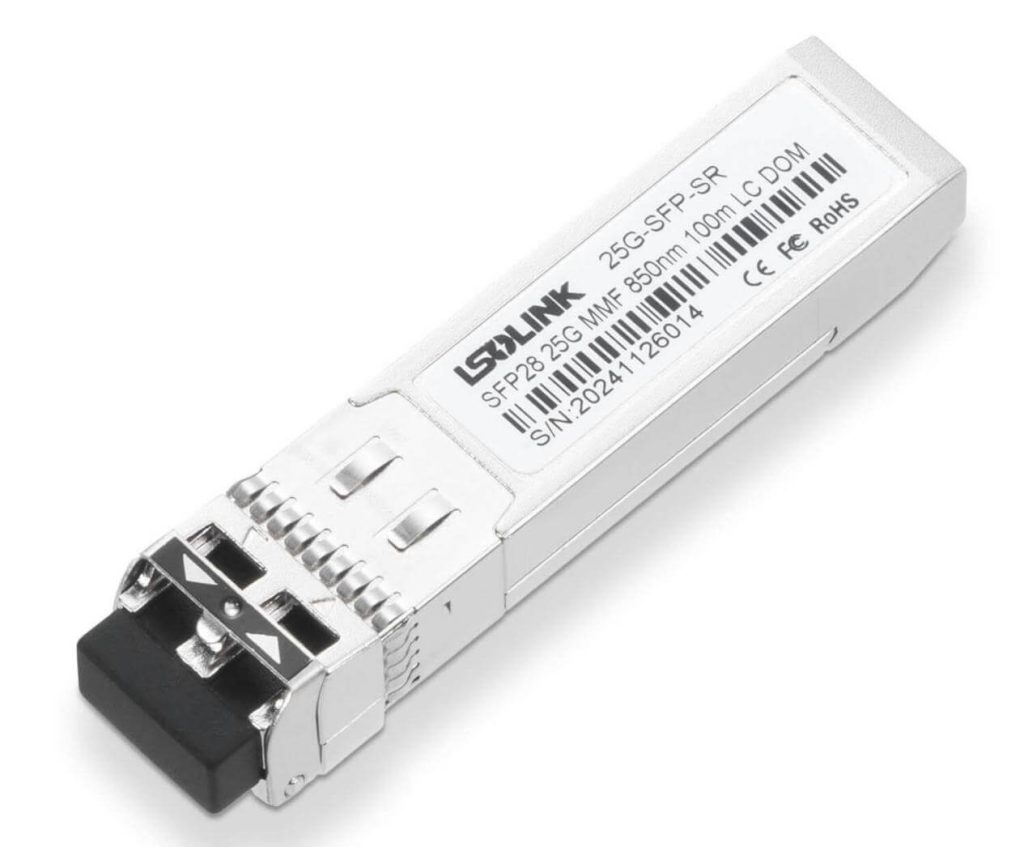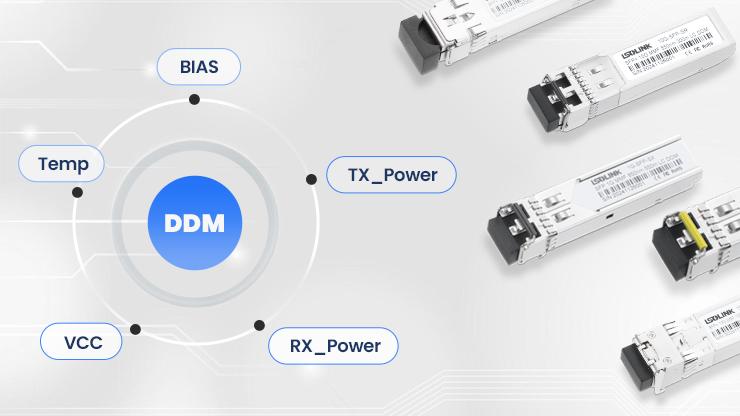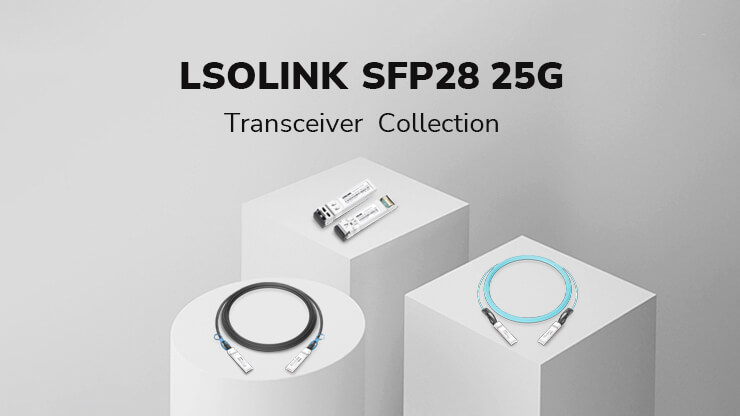SFP28 25G SR vs. 10/25G Dual-Rate SR: Key Differences Explained
With the promotion and deployment of 5G, the demand for efficient, high-speed connections in telecom networks is increasing. 25G SR modules are becoming increasingly popular in telecom networks due to their compact size, 2.5 times the speed of 10G SR modules, and their ability to smoothly connect to 100G SR4 modules. This has prompted the migration of networks to 25G speeds, but older 10G network equipment still has room for improvement. This is why the 10/25G dual-rate SR module has emerged. It supports automatic switching between 10G and 25G speeds and is compatible with both 10G and 25G networks. This article analyzes the differences and technical features of SFP28 25G SR and SFP28 10/25G dual-rate SR, providing a clear selection guide for telecom network architects.
Parameter Differences Between SFP28 25G SR and SFP28 10/25G Dual-Rate SR
The SFP28 25G SR is a single-channel, pluggable optical module that uses a VCSEL laser operating at an 850nm wavelength. It’s suitable for short-haul transmission, offering a transmission distance of 100m on OM4 fiber (note that FEC must be enabled for stable transmission). It complies with the SFF-8472 and SFP28 MSA protocols, with a transmission rate of 25.78125Gbps. Four SFP28 25G SR modules can be connected to the four channels of a QSFP28 100G SR4 module to achieve 100G transmission speeds. The SFP28 25G SR module consumes only 1W of power, making it suitable for high-density deployments.

The SFP28 10/25G dual-rate SR module is also a single-channel, pluggable optical module. It utilizes a VCSEL laser operating at an 850nm wavelength, making it suitable for short-haul transmission. It complies with the SFF-8472 protocol and the SFP28 MSA. However, unlike the SFP28 25G SR optical module, its PHY chip not only supports 25.78125Gbps but also provides support for SFP+ ports and 10G speeds by downscaling. Transmission distance scales with speed, offering a 70m transmission distance over OM3 fiber at 25G speed and a 100m transmission distance over OM3 fiber at 10G speed. Because the SFP28 10/25G dual-rate SR module utilizes a dual-rate PHY chip, its power consumption is slightly higher than that of single-rate modules, at 1.2W, this consideration should be taken into account when using it in high-density applications. Of course, four SFP28 10/25G dual-rate SR modules can also be connected to the four channels of the QSFP28 100G SR4 module to achieve 100G transmission rate.
| Product Parameters | SFP28 25G SR | SFP28 10/25G Dual-Rate SR |
| Form Factor | SFP28 | SFP28 |
| Laser | VCSEL | VCSEL |
| Wavelength | 850nm | 850nm |
| CDR | TX & RX Built-in CDR | TX & RX Built-in CDR |
| Power | 1W | 1.2W |
| Maximum distance | 100m@OM4/70m@OM3 | 100m@OM4/70m@OM3 at 25G100m@OM3 at 10G |
| Compatibility | SFP28 | SFP+/SFP28 |
| Speed | 25G | 10G/25G |
| FEC | Support | No support |
Differences in Application Scenarios Between SFP28 25G SR and SFP28 10/25G Dual-Rate SR
The SFP28 25G SR module only supports pure 25G network applications or applications where 25G networks are smoothly upgraded to 100G networks. The 25G SR module is also a frequent choice for 5G fronthaul applications. Its 25G speed balances performance and cost, enabling high-speed interconnection between base stations and meeting the low-latency, high-bandwidth demands of 5G services.
The SFP28 10/25G dual-rate SR module is mainly used in 10G, 25G, and 100G hybrid networks. Multi-rate parallel links can maximize the advantages of dual rates, reduce the number of spare parts, and simplify installation and management. The SFP28 10/25G dual-rate SR module is also a major application in the smooth upgrade from 10G to 25G networks. It can provide support for higher-rate networks while retaining older equipment, gradually replacing older equipment, reducing costs, and alleviating financial pressure.
Which Is the Best Choice for Your Network: SFP28 25G SR or SFP28 10/25G Dual-Rate SR?
- Multi-rate mixed network scenario
In a multi-rate hybrid network, the SFP28 10/25G dual-rate SR module is the best choice. One module supports two rates, suitable for both 10G and 25G networks. There is no need to replace the device when switching rates. When multiple rates are running in parallel, one module can also be used to meet the needs, reducing the number of spare parts and alleviating operation and maintenance pressure.

- Single-rate network scenario
In a single 25G rate network, since there is no need to support 10G rates, SFP28 25G SR is a better choice. Its lower power consumption and cost, as well as good network consistency, are advantages that cannot be ignored in large-scale network construction. It can also avoid potential network risks caused by different rate negotiations.
- Gradual network upgrade
When upgrading most office or campus networks, the old equipment (10G speed) still needs to run to ensure the normal transmission of services, so only some nodes are upgraded to 25G speed. In this scenario, the SFP28 10/25G dual-rate SR module is the best choice for network upgrade. With the existing fiber optic network, the network upgrade can be easily achieved. When the network is upgraded from 10G to 25G, there is no need to replace optical modules and cables. In addition, when upgrading the 25G network to 100G network, only 100G equipment can be purchased. While retaining the old equipment, the 25G network can be upgraded to 100G network through breakout application, which greatly reduces the network upgrade cost.
Conclusion
SFP28 25G SR vs. SFP28 10/25G Dual-Rate SR: There’s no best, only the most suitable. The SFP28 25G SR and SFP28 10/25G Dual-Rate SR modules offer the same functionality, but each has its own distinct focus. They complement each other. When deploying a network, consider current network conditions and future upgrade requirements to choose the most suitable product and build the most suitable network.
We hope this analysis of the differences between the SFP28 25G SR and SFP28 10/25G Dual-Rate SR modules is helpful. LSOLINK, as a professional solutions provider, is here to protect your network.








